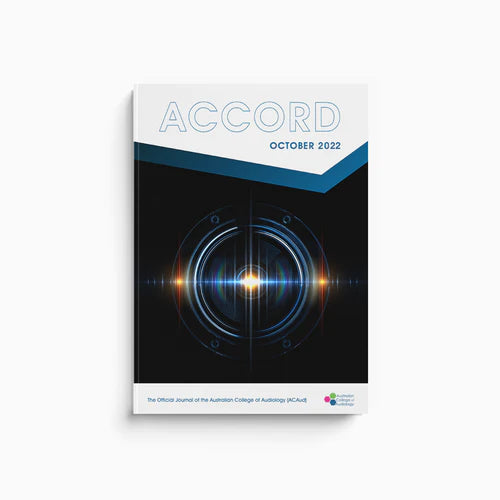Originally published in Accord October 2022
By Ian O’Brien PhD MAudSA(CCP),
Research Audiologist, Audeara
Principal Horn, Queensland Symphony Orchestra
Music and its place in life
Music is an important part of many people’s lives, whether they are musically inclined or not. For some it is an expression of their identity, or part of their communication. For others it is a lifestyle enhancement, a way to connect to or remember loved ones, or it may simply be used as a mood booster or to reminisce. Music is also critical to positive ageing, especially regarding self-esteem and social connection1.
The impact of hearing loss on music enjoyment is well-documented, with some studies finding that around half of those with hearing loss report effects on their enjoyment of music2, and this becomes more of an issue as people age3.
An important part of our role as hearing and communication specialists is to ensure our clients enjoy continued positive engagement with music. This article will look at current design challenges of reproducing recorded (not live) music and media on personal listening devices, approaches to the personalisation of these signals for the hearing impaired and will compare the performance of the three main device types.
Music ‘quality’
There are many challenges associated with music reproduction generally. When it comes to our favourite music, we know what we like and tend to be fussy about what we hear. Our ears - impaired or not, trained or not - are well tuned to distortions or artefact in the signal, often described in terms of sound ‘quality’. But what is meant by ‘quality’ in this context? Most of the published literature tends to focus on dynamic range and spectral balance.
Dynamic Range
Compared to live speech and music signals, recorded media typically has a smaller dynamic range, particularly with recent pop music releases. However, further reduction or alteration of this dynamic range is closely associated with a perceived loss in music quality by both trained and untrained listeners4.
Spectral balance
There is much discussion regarding the ‘ideal’ spectral response in headphones and earphones. While clearly a highly subjective issue, research at Harman International has shown that age, gender and listening experience are all important factors, particularly in the bass and very high frequency areas. The Harman target response curves (based on mimicking loudspeaker response in a semi-diffusive room) are today an industry-wide starting point for many manufacturers of high-fidelity headphones and earbuds. Excessive deviation from these ‘ideal curves’ has been shown to negatively impact the perceived audio ‘quality’5.
Personalisation of music signals
Hearing impaired listeners share a similar intolerance to changes in dynamic range and the spectral balance of music signals to those with unimpaired ears. Applying speech-oriented algorithms with compressed or even semi-compressed dynamic range has been shown to impact the perception of music quality and is significantly less preferred to linear processing by hearing impaired listeners5. While non-linear processing is obviously a requirement for some hearing losses, careful application is necessary to avoid ‘squashing’ the music signal. In real terms this results in a loss of clarity and instrument balance, especially considering most of today’s pop music dwells almost completely in the top 15-20 dB of the ‘dBFS’ (‘full-scale’) range.
Spectrally, due to the non-linear loudness growth of impaired ears, choices must be made about presumed listening levels and the weight of amplification at various parts of the spectrum. Further to this, a typical audiogram (250-8000 Hz) covers a five-octave range starting at a (slightly sharp) ‘middle c’ on the piano, leading to extrapolation over three octaves of audible bass and the octave or so above 8 kHz associated with brilliance, clarity and ‘air’6. Although it is true that there are some listeners who have little functional hearing in the very high frequencies, there are also many with hearing loss who benefit greatly from amplification above 8 kHz. Similarly, incorrect assumptions around low frequency hearing ability can result in over- or under-amplification in this region, resulting in either ‘muddy’ or ‘thin’ signals, respectively.
Hearing device choices
Common personal devices for recorded music and media are headphones, earbuds and - increasingly - hearing aids with streaming capabilities. The functional delineation between hearing aids and wireless earbuds has blurred, with each making strong incursions into the domain of the other, whether it be hearing speech in noisy situations, tinnitus management, music streaming or phone use. Headphones are also extending their capabilities, with the latest noise cancelling models featuring ‘pass-through’ as standard.
Earbuds
Today’s earbuds can have excellent sound reproduction, noise cancellation, phone functionality and even ‘personalised’ pass-through similar to a hearing aid7. While convenient, perhaps their main drawback is comfort and form factor. The requirement for insertion and occlusion of the ear canal for effective bass response means that users with small or unusually shaped ear canals or who dislike something in their ear canal for long periods can struggle to find a usable solution.
Headphones
Many users prefer to have their audio delivered by over- or on-the-ear headphones, whether for convenience, comfort or both. A well-designed headphone sits comfortably on the ears with little clamping force, making them suitable for longer listening periods. Advances in active noise cancelling can provide high isolation with very little occlusion and the large ‘dynamic’ drivers in these devices ensures plenty of bass power and clarity, even in ‘open-backed’ models.
Hearing Aids
Most of today’s hearing aid manufacturers offer devices with music and media streaming. While very convenient for those with hearing loss, constraints and limitations with the fundamental design of hearing aids can cause challenges when listening to these signals. This includes poor bass response with open-fit and vented devices and pronounced nonlinear dynamic range processing. Additionally, the necessary focus of hearing aids on live speech signals can leave both the bass and very high frequency content neglected. While various manufacturers have sought to address these issues either through mechanical innovation8 or through algorithm design9, definitive solutions seem elusive to date.
Current hearing aids are also limited due to the single balanced armature driver used in most common receivers. Although capable of full spectral reproduction, single drivers can struggle to faithfully reproduce the full audible spectrum simultaneously. It is for this reason most in-ear monitor manufacturers use multiple drivers, often claiming that “unmuddied” bass and clear high frequency responses require dedicated drivers tuned to different parts of the spectrum10.

Device comparison
By way of illustrating these points, Figures 2 and 3 compare the spectral and dynamic range responses to Bluetooth streamed test signals of a popular recent model headphone, earbud, and hearing aid from three high-profile brands. These tests were performed on a KEMAR head and torso simulator fitted with GRAS anthropomorphic pinnae, coupled to an Acoustic Precision acoustic analyser.
Figure 2 shows the spectral response of the three devices. The headphones adhered mostly to the Harman response curves below 6 kHz with pronounced sub-bass (under 60 Hz) but boosted very high frequencies closely followed a typical ‘free-field’ response13 resulting in a clear, spacious sound when compared to the other devices. The earbud showed a less pronounced bass and a sharp fall above 8 kHz, lacking power and fullness. The hearing aid fell steeply above 6 kHz, impacting clarity and brilliance, while a bias between 60-250 Hz combined with a dip between 500-1500 Hz imparted a muddiness and lack of presence.

Figure 2. Spectral responses of various devices to swept sine test signal streamed through Bluetooth (normalised at 500 Hz)
From an input/output perspective (Figure 3), while the headphone and earbud were linear (input = output) the hearing aid applied heavy input compression at around -10 dBFS (regardless of user-selected listening level). This results in a loss of separation and balance between instruments in a very important part of the dynamic range for recorded music.

Figure 3. Input/output responses of various devices to stepped sine test signal streamed through Bluetooth
There are many hearing aids, earbuds and headphones on the market and wide range of approaches to spectral and dynamic range processing. The above results represent a very limited sample and are for illustrative purposes only.
Conclusion
While great advances have been made in delivering music and media through hearing aids, there are still challenges to be overcome in order to provide a true high-fidelity experience to all users. Earbuds are developing quickly but still face physical and mechanical design limitations. For now, headphones still consistently provide a high quality and comfortable personal listening experience. Hearing impaired listeners are benefitting greatly from a deeper understanding of algorithm design for music enhancement combined with new technology available to tailor headphones to hearing profiles.
At Audeara our Bluetooth headphones can be fitted to the user’s audiometric profile through our AudAssist Desktop software (only available to clinicians) or through our consumer mobile app. We are continually undertaking R & D to improve our innovative personalisation algorithms and fitting parameters to ensure all listeners receive the highest quality sound for their streamed music and media, regardless of their hearing profile.
This is an increasingly competitive space - which is great news for the consumer - and clinicians should keep a keen eye on this fast-moving market on their client’s behalf.
References
- Hays, T. (2005). Well-being in later life through music. Australasian Journal on Ageing, 24(1), 28–32. http://doi.org/10.1111/j.1741-6612.2005.00059.x
- Leek, M., Molis, M., Kubli, L., & Tufts, J. B. (2008). Enjoyment of music by elderly hearing-impaired listeners. Journal of the American Academy of Audiology, 19(6), 519–526. http://doi.org/10.3766/jaaa.19.6.7
- Solheim, J., Kværner, K., & Falkenberg, E. (2011). Daily life consequences of hearing loss in the elderly. Disability and Rehabilitation, 33(23-24), 2179–2185. http://doi.org/10.3109/09638288.2011.563815
- Kirchberger, M., & Russo, F. (2016). Dynamic Range Across Music Genres and the Perception of Dynamic Compression in Hearing-Impaired Listeners. Trends in Hearing, 20. http://doi.org/10.1177/2331216516630549
- Olive, S. (2022). The Perception and Measurement of Headphone Sound Quality: What Do Listeners Prefer? Acoustics Today, 18(1), 58–67. http:// doi.org/10.1121/AT.2022.18.1.58
- Headphonesty.com (2021). The Audio Frequency Spectrum Explained. Retrieved September 25, 2022, from https://headphonesty.com/
- Chong-White, N., Mejia, J., & Galloway, J. (2021). Evaluating Apple AirPods Pro with Headphone Accommodations as Hearing Devices. The Hearing Review, 28(12), 8–11.
- Latzel, M., Meija, J., Young, T., & Hobi, S. (2022). ActiveVent™ Receiver Benefits. Phonak Field Study News. https://www.phonakpro.com/au/en/ resources/information-forms/evidence/Library.html
- Brændgaard, M. (2021). The Development Behind Oticon MyMusic. (Technical Paper). https://www.oticon.com.au/professionals/audiology- and-technology/technologies/research
- Pro.Meeaudio.com (2022). Are the best in-ear monitors those with the most drivers? Retrieved September 25, 2022, from https://pro.meeaudio.com/
- Ilkless. (2021). A Deep Dive Into Harman Curves. Headphonesty.com. Retrieved September 25, 2022, from https://www.headphonesty. com/2020/04/harman-target-curves-part-3/


